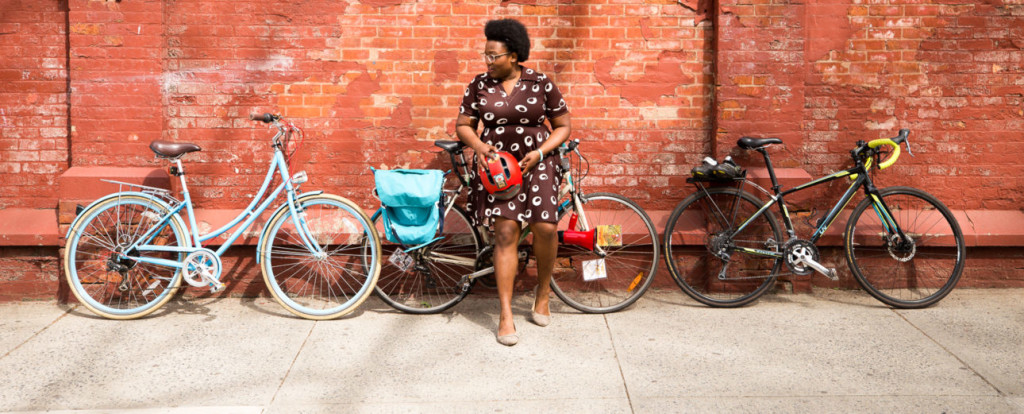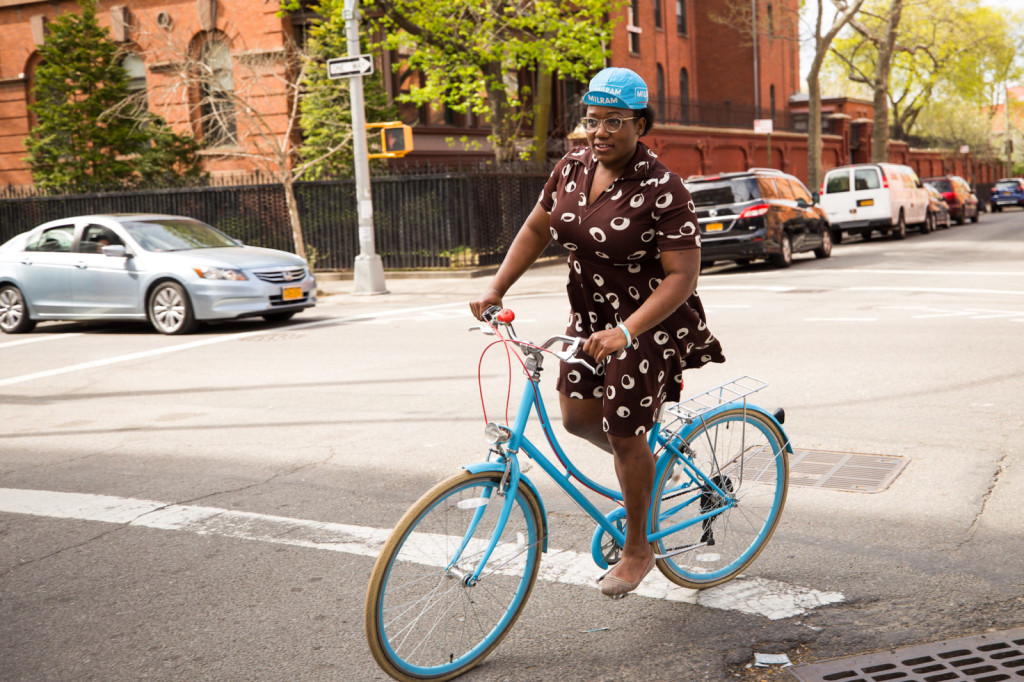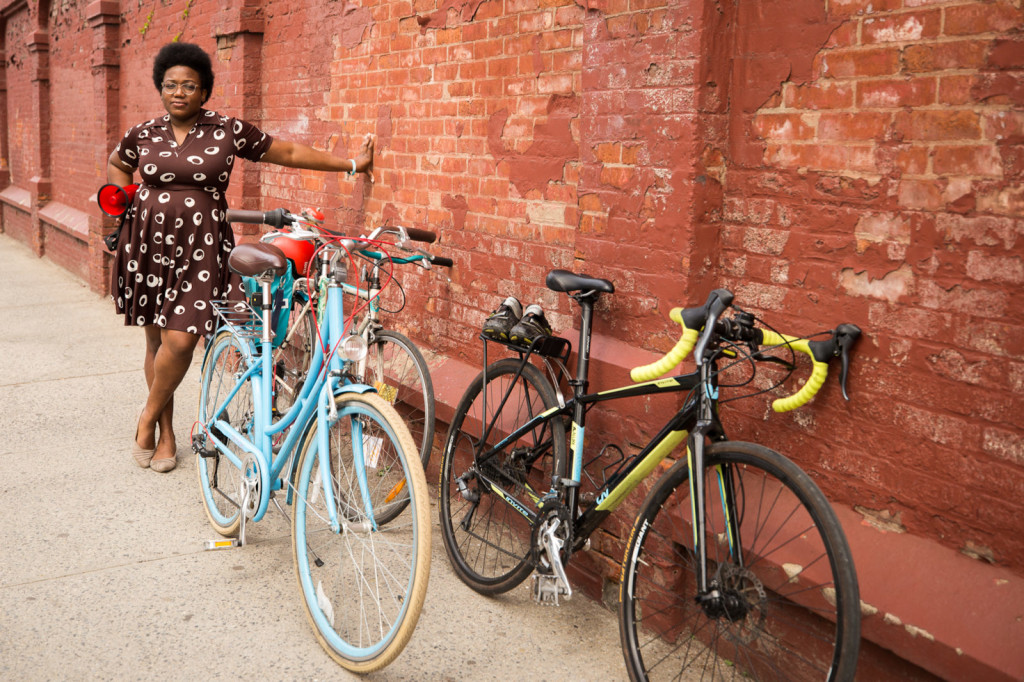She fell in love with cycling, but was tired of never seeing anyone else who looked like her on two wheels. So she did something about it.
Throughout May, National Bike Month, our People of Interest series is spotlighting New York cyclists who are breaking the mold and making a difference on two wheels.
“My community has a lot of problems that are institutionally heaped upon it that may never be resolved,” says Courtney Williams, a 32-year-old African-American woman who lives in Brooklyn. “But we still have a need to take care of ourselves, and I know this sounds really hippy-dippy, but bicycles are these magic machines that can kind of cure all.”
Williams, who works in business planning and development counseling, is on a quest to bring the joy of those magic machines to more people in communities of color. “I just want people to experience the joy that I feel when I’m on a bicycle,” she says. “I don’t want people missing out.”
Cycling is so woven into Williams’ life that it takes three bikes to accommodate her needs: one for long-distance rides; a twelve-speed for locking up on errands and short trips around the city; and a pretty sky-blue cruiser for when she wears dresses. But not long ago, she didn’t bike at all.
Growing up in Gary, Indiana, Williams liked to ride, but it eventually fell by the wayside. Then she looked out her window one day, a year after moving to New York in 2009, and noticed a new bike lane running through her Brooklyn neighborhood. She got a bicycle – a heavy steel framed one that was too small and not very good – and started riding. The next year she did the forty-mile Tour de Bronx, a sightseeing ride that draws thousands every year and ends with a party at the Botanical Garden. That affirmed that she could handle distance, and left her with the urge to venture out beyond the Bronx. “I didn’t know where I wanted to go, but I knew I was going to go places,” she says, sitting at the Pillow Cafe on a recent afternoon near her home in Brooklyn.
But she didn’t want to do it solo. Over the next few years, she became a regular in the city’s cycling scene, going on rides with advocacy groups like Transportation Alternatives and We Bike NYC, which promotes women in cycling. She also came across Black Girls Do Bike on Facebook, which looked promising but didn’t have any local rides in New York.
Any time she’d see a black woman anywhere on a bike, Williams would go up to her and ask, “Do you know there are other black women on bikes like you?” The response, she says, would always be: “I thought I was the only one.”
Meanwhile, she was learning from her excursions, and saw that a lot of the people on these rides had buddies. “And I was like, ‘where’s my buddy?’” she recalls. “Then one day I just decided, ‘I’m going to make this happen.’”
Williams asked Black Girls Do Bike if she could organize a New York event, got a green light, and in May 2014 ten women showed up at Grand Army Plaza in Brooklyn for her first ride. Wanting it to be purposeful, she took them to a bike fair in Park Slope, and for the next two years, led two rides every month for the BGDB New York chapter. “It became my second full-time job,” she says of the volunteer planning, promoting and riding. “I made sure everything was seamless. My approach was to create a one-hundred-percent-sincerely welcoming environment,” one in which no one would get left behind.
To boost “rider development,” she noted which women were having trouble and followed up with them to help. She would also offer instruction during rides, showing the novices how to signal and when to change gears. She offered both long and short rides, and took participants to women-centric bike events like CycloFemme, an annual global ride for women on Mother’s Day, as well as to non-biking female empowerment events like the Women in Comics Convention in the Bronx.
Joneé Billy, who is 32, lives in Crown Heights, Brooklyn, and works in community development, first met Williams two years ago and was impressed when she came across her leading a huddle of women. “She took command,” says Billy, who was new to cycling herself, “and that’s what drew me to her.”
Billy went on many of Williams’ Black Girls Do Bike rides, which she describes as “safety first,” but also “lighthearted and fun,” and eventually became a leader. She says Williams “pushed me and other ladies like me to do more, to venture out and seek other opportunities,” whether taking an intensive bike maintenance class or doing something they didn’t think they were physically capable of – like bicycle racing on a velodrome track, which Billy says will be her next step. “She motivates ladies to do whatever the next level is for them, to accomplish that goal, and then to step it up,” she says.
Maudene Nelson, a 67-year-old cycling enthusiast and nutritionist who lives in Yonkers, just north of the Bronx, also appreciates Williams’ leadership. “I know there are women who’ve been influenced by Courtney’s role in encouraging all of us to be mentors,” she says, “and I credit her for having created the environment for the rest of us to help others get into cycling.”
Williams’ rides were open to whoever wanted to join. But the point for Williams was to ride with people like her, as she puts it, and to create “a safe place for black women to feel relaxed about their particular needs and concerns about cycling.”
African-Americans were systematically excluded from cycling for a long time, as with other sports in U.S. history, and ended up doing it less as a result. That seems to be rapidly changing. According to a 2013 report by the League of American Bicyclists and the Sierra Club, from 2001 to 2009 ridership among African-Americans doubled, despite the lack of representation in advocacy groups and the lack of cycling infrastructure in communities known as “transit deserts.” A number of minority cycling groups have sprung up in recent years all over the country, including Red, Bike & Green, a collective founded in 2007 and aimed at creating a black bike culture; and the National Brotherhood of Cyclists, founded the following year by a network of affiliated black cycling clubs. In 2011, a group called Black Women Bike: DC was formed and two years later the national Black Girls Do Bike was born on Facebook. There are many more.
Last year, Williams ended her time with Black Girls Do Bike due to disagreements over how it was being run and decided to apply her talents to starting up The Brown Bike Girl, a bicycle consultancy. Her goal is to “grow other leaders of color,” she says, along with more cyclists. “I’m there to directly work with a brother and sister who loves cycling and wants to start their own club or initiative or whatever iteration of cycling they want to bring to their community. I’m here to help institutions and individuals who want to do that. There’s definitely a need for it.”
Looking ahead a year or two, Williams envisions running bike club organizing 101 workshops, and those resulting in many new bike clubs for people of color. She also hopes to work with nonprofits to support campaigns in underserved POC neighborhoods. “Everything is on the table,” she says. “People with the power – this includes average Joes and Janays who need to recognize the power in themselves – just need to reach out, be serious about bringing more people to the fore, and we can put our heads together and work it out. Sky’s the limit.”
Williams recalls a recent chat about her cycling advocacy with a black man she met in the park one evening: “He was like, ‘Why do you want black people to cycle so much? Is it just because you like it?’ And I was like, ‘Yes! That’s exactly it! I have found something that’s very good for me, and if it’s good for me then I know it’s good for other people.’”
She cites the mental and physical wellness that cycling promotes, which would be a boon for black communities that face higher levels of diabetes, high blood pressure and heart disease, as well as the pure joy it brings to her.
As she moves into this next phase of her bike journey, she is pleased to see that some of the women she helped motivate over the past few years, like Joneé Billy, have moved beyond her circle.
“I feel like a lot of my women have outgrown me or surpassed me,” Williams says, “because they’ve started going to other clubs and are participating in other cycling opportunities that they didn’t know about before because they weren’t part of bicycle culture.”
And that, she says, was just what she had in mind.
>via: http://narrative.ly/courtney-williams-is-on-a-mission-to-get-black-women-to-bike/





